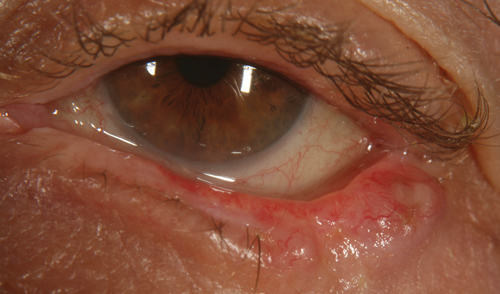 |
As Review of Cornea & Contact Lenses prepares to take its summer break, Lens Care Insights is shifting its focus this month to cover an important topic that impacts all of your patients, especially this time of year, regardless of age, gender and whether they wear contact lenses or spectacles.
Sun exposure is the number one cause of wrinkles and other signs of aging, and more serious conditions like basal cell carcinoma, squamous cell carcinoma and melanoma, particularly in the periorbital area.1 Yet some optometrists, who may be the first to notice these potentially deadly conditions, neglect to remind patients to use even the simplest form of skin protection available.
Public Service Announcement
The American Academy of Dermatology recommends use of a broad-spectrum sunscreen with a minimum sun protection factor (SPF) of 15 to protect against both ultraviolet A (UVA) and ultraviolet B (UVB) rays. UVB rays remain closer to the surface of the skin and are the primary cause of sunburn and skin cancer, while UVA rays penetrate deeper into the dermis and contribute to premature aging. Sunscreen should be used year-round for any exposure time greater than 20 minutes and should be applied to dry skin 15 to 30 minutes before going outdoors, and reapplied every two hours. This includes water resistant sunscreens, which begin to lose their effectiveness after 80 minutes.
 | |
| Squamous cell carcinoma. |
Sunscreen can be classified as one of two major kinds: chemical or physical (i.e., sunblock). Chemical sunscreens are available as ointments, creams, gels, lotions and wax sticks and contain broad-spectrum ingredients like benzophenone, oxybenzone, sulisobenzone, and avobenzone that act as filters to reduce the penetration of UV radiation into the skin.2 Sunblocks, on the other hand, contain titanium dioxide and zinc oxide that physically block UV radiation.2 These are available as both creams and powders, which can be easily applied over the skin and the eyelid region without a change in cosmetic appearance, and are regarded by many skin care specialists as having superior UV control. Regardless of which type of sun protection is used, however, dermatologists recommend making sure the product is approved for use around the eye and to use either balms or wax sticks when possible, as these are less apt to drip into the eye following application.
The Cosmetic Angle
Many people who wear foundation in the periorbital area to even out skin tones or cover up blemishes may choose a particular brand based on the belief they are protecting their face from sun damage. Ironically, however, skin type and facial movement throughout the day can cause the foundation to pool in the fine lines of the face, called dermatoglyphs, leaving some parts of the skin open to sun exposure. Patients with oily skin and those using foundations in cream or powder form are more prone to rapid migration. As with sunscreen, any foundation being used for sun protection purposes should be reapplied every two hours.
Of course, ointments, lotions and creams don’t protect the eye itself from sun damage. It’s important to educate patients on the necessity of sunglasses. Beyond looking “cool,” sunglasses protect the eye from photokeratitis, cataracts and retinal damage. Even in the winter or in shady areas, eye protection is still recommended, as reflected light can be just as damaging.
Both cataracts and skin cancers are the result of years of accumulated sun exposure; thus, precautions should be taken early with small children, although sunscreen use is not FDA-recommended for children under six months of age.3 Early intervention can mean years of healthy living.
For more information on aesthetics and the eye, check out a special feature in the upcoming July issue of Review of Optometry!
1. Tsatsou F, Trakatelli M, Patsatsi A, et al. Extrinsic aging. Dermatoendocrinol. 2012 Jul 1;4(3):285-97.
2. Melanoma Foundation. Facts About Sunscreen. Available at: www.melanomafoundation.org/prevention/facts.htm. Accessed May 19, 2015.
3. U.S. FDA. Should You Put Sunscreen on your Infants? Not Usually. Available at: www.fda.gov/ForConsumers/ConsumerUpdates/ucm309136.htm. Accessed May 19, 2015.


